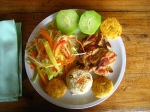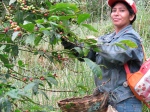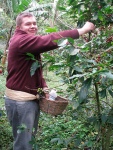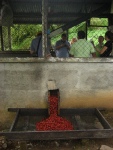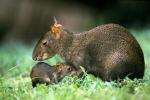

Earlier this year, I received a scholarship from Counter Culture Coffee Roasters in Durham, North Carolina. The scholarship was a full, two weeks paid trip to Nicaragua to learn all about coffee before it comes into the States. On the way back from Nicaragua, we would fly back to Durham and get a chance to the roaster and see everything from coffee roasting to their cupping and selection processes. This was a dream come true and it really opened my mind to how much hard work goes into one cup of coffee which way too many of us take for granted. This is the first installment of three posts to cover this trip and all pictures are at the end of each post.
Day One: New York to Managua, Nicaragua
Being the recipient of this scholarship meant that Denise Hall, Café Operations Professor at the Culinary Institute of America and one of the advisers of the Fine Grind Society would also accompany me. We flew out of Newark early in the morning for our meet-up with the rest of the group in Houston. From here we flew straight to the capital, Managua, Nicaragua. We walked right across the busy intersection from the airport to our hotel, the beautiful Hotel Las Mercedes which I highly recommend! After a few Toñas and getting to meet the rest of the group it was time get to bed early for our three hour drive into the mountains of Mataglapa early in the morning.

Day Two: Managua to San Ramón
Early in the morning we met a man named Giff Laube. He was the Manager of Finca Esperanza Verde. An organic, shade-grown, bird friendly Eco-Lodge and Coffee Farm. A few hours later we arrived at the base of the mountain and had to divide the group into two trucks to get up through the rough terrain. As we climbed the mountain, Giff pointed out all of the local coffee farms (fincas) and explained what varietals of coffee they grow and a little bit about each farmer.
We finally arrived at the lodge and were greeted with an amazing lunch. We then unpacked and regrouped for our tour of Finca Esperanza Verde (The Farm of Green Hope). Giff, showed us the many coffee varietals the farm grows, their butterfly sanctuary, the exotic wildlife and where we would be picking our own coffee cherries the following morning.
Day Three: The Harvest!
I woke up early this morning to do some exploring on the farm before our long day of cherry picking. I woke up throughout the night because of these loud squealing noises I heard outside. The workers on the farm told us about these rodents called guatusas which are very similar to large guinea pigs and they are very attracted to wild peanuts; and sure enough, I dug up a few plants in this curious little patch right outside my window and found a ton of the tasty legumes.
Soon after-wards I met up with the rest of the group and we donned our cherry picking baskets and set out into the forrest, foraging for the ripest cherries we could find. Most Arabica coffea varietals ripen into a very dark red color, there are also a few varieties that ripen into a bright greenish yellow. Since we were all amateurs and didn’t notice the difference we stuck with collecting the red cherries.
Cherry picking is not easy work and does come with dangers. While picking I reached into a shrub and didn’t even notice the poisonous snake that was right next to my hand until one of the workers jerked my hand away. Fallen banana plants are also another concern which still haunts the dreams of Cindy Chang, the Director of Development at Counter Culture which was on this trip with us and always seems to be the one to slip on them and get covered in rotting plants. Banana plants are herbs and decompose very fast and when they lay covered by foliage decomposing on a steep mountainside, they can be extremely dangerous.
After picking for about four hours we decided to head back to the wet mill and process our cherries. When comparing our harvest to the workers harvest, we only picked about a third of the amount per person. Some of these pickers are so experienced that in one six hour shift can pick over 100 pounds of the highest quality fruit and only walk away with only 60 to 90 Cordobas, $3.00-4.50 per day. And this is the pay at Finca Esperanza Verde which pays a 50% premium to the workers to pick only the ripe cherries. It made me value every cent I had even more and gave me a stronger appreciation for Fair Trade coffee buyers. And you might say to yourself, “well, everything in the country is cheaper to match the pay rate, right?” No, chips and soda at the nearby convenience stores were even more expensive than here in the States.
We then floated our cherries. Ripe cherries will always sink when placed in water. Any ‘floaters’ are scooped away and discarded. The floaters may be unripe cherries or cherries that have been invaded with tiny bugs that live inside the fruit, breathing and eating the flesh making the cherry buoyant. The cherries then get depulped by a simple machine that gently squeezes each cherry; which pops out the seed (coffee bean) and discards the fruity flesh. The seeds then sit in a concrete basin and ferments for 18-36 hours, usually overnight. During this time, the mucilaginous goo around the seed breaks down, making washing much easier.
The seeds are then washed to separate any fruity flesh that may fallen into the fermentation basin and to clean each seed. If the seeds are not washed properly, they cannot dry properly and will quickly go rancid. For the initial drying, the water content is brought down to about 40% to allow shipping for further drying and processing.
The Pictures


